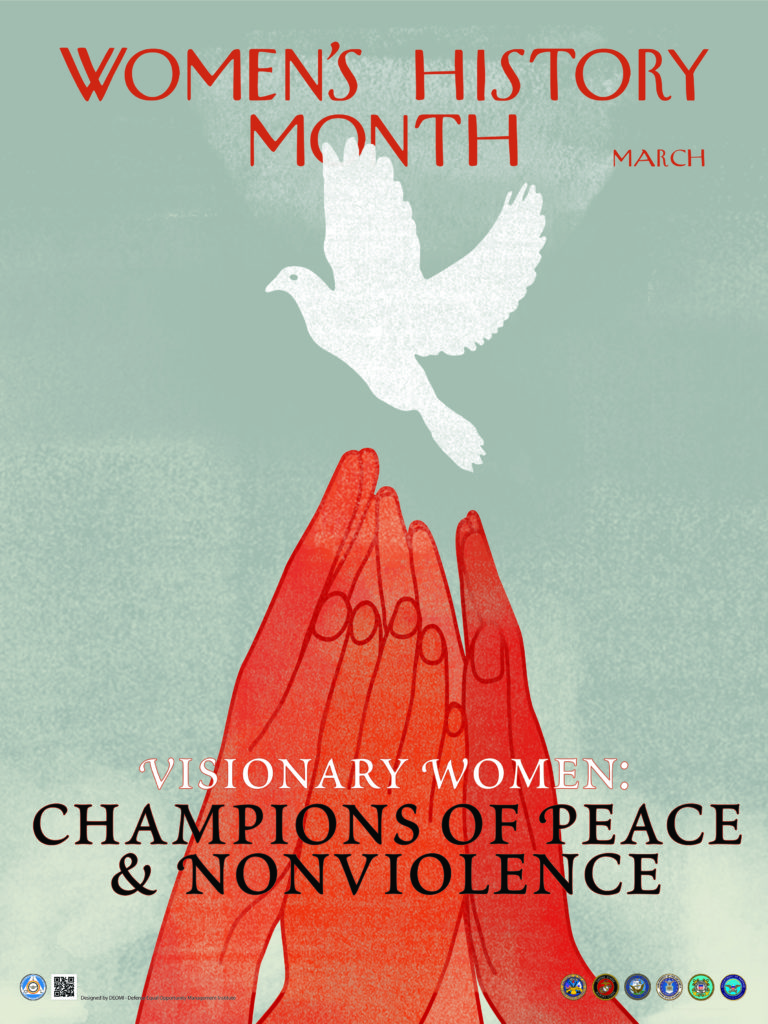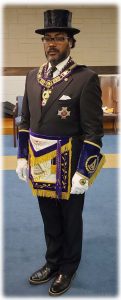 Theme: “Visionary Women: Champions of Peace and Nonviolence”
Theme: “Visionary Women: Champions of Peace and Nonviolence”
Background: The evolution of honoring women began on March 8, 1857, when garment workers in New York City staged one of the first organized protests by working women. Women’s groups internationally have designated times to mark this day. In an effort to begin adding women’s history into educational curricula, a Women’s History Week was initiated in 1978. By 1981, the week was a national event, and in 1987, the National Women’s History Project petitioned Congress to include all of March as a celebration of women.
This year’s theme focuses on women who have led efforts to end violence and injustice. They have rejected violence as counterproductive and stressed the need to restore respect, establish justice, and reduce the causes of conflict as the surest way to peace. The poster depicts a distressed grey-white background. Centered at the top in capitalized text is the observance’s title, “Women’s History Month” in orange letters. Stretching upward in the bottom center are four outstretched hands in orange color reaching up the middle of the poster. A white dove is just above the fingertips flying upwards to the poster’s left, as if released from the hands. The right wing of the dove slightly covers the “O” in the word “Month.” At the bottom center of the poster in white text and capital letters is the first part of the observance theme, “Visionary Women:” Centered immediately below the introductory text is the remainder of the theme in slightly larger font and black, capitalized text, “Champions of Peace & Nonviolence.” At the bottom left corner is the Defense Equal Opportunity Management Institute (DEOMI) seal, a quick response code, and in smaller text the words, “Designed by DEOMI – Defense Equal Opportunity Management Institute.” At the bottom right corner are the Service seals for the Army, Marines, Navy, USAF, Coast Guard, and Department of Defense in consecutive order.
Quote:
“When the whole world is silent, even one voice is powerful.”
-Malala Yousafzai
For the remainder of the month, an inspirational quote from a woman, and a brief history of woman will be highlighted for her contribution and efforts to end violence and injustice. If there is woman who has inspired you that you would like to highlight, please feel free to share.
Prepared by Logan S. Young, Contractor
March 1 – Each year, the National Women’s History Project selects a theme that highlights achievements by distinguished women. This year’s theme: Working to Form a More Perfect Union: Honoring Women in Public Service and Government, highlights women who have shaped America’s history and its future through their public service and government leadership. http://www.nwhp.org/
March 2 – In 2012, Janet C. Wolfenbarger became the first female four-star general in the U.S. Air Force. After receiving her fourth star, she became the commander of Air Force Material Command. She had previously served as military deputy in the Office of the Assistant Secretary of the Air Force for Acquisition at the Pentagon, where she oversaw research and development, testing, production, and modernization of an annual $40 billion in Air Force programs.
http://www.af.mil/AboutUs/Biographies/Display/tab id/225/Article/107934/general-janet-cwolfenbarger.aspx
March 3 – Clara Louise Maass volunteered to serve as a contract nurse during the Spanish American War in 1898. After the end of the war, she participated in a experimental program in Cuba to determine the cause of yellow fever. During her time researching and caring for the sick, she became infected and died.
http://www.nursingworld.org/ClaraLouiseMaass
March 4 – Grace Hopper joined the Naval Reserve during World War I and continued to work for the Navy as a reservist. In 1952, the computer-programming pioneer developed a program that translated programming language into machinereadable code –the first step in the creation of the universal programming language, COBOL. She served for 30 years and was later honored posthumously with the christening of the USS Hopper in 1996.
http://www.sdsc.edu/ScienceWomen/hopper.html
March 5 – Tulsi Gabbard was born in American Samoa in 1981 and moved to Hawaii at age two. When she was sworn in as a congresswoman in 2013, Gabbard became one of the first two female combat veterans, the first Hindu, and the first woman of Samoan ancestry to serve as a member of the U.S. Congress. In 2003, she joined the Hawaii National Guard and volunteered to deploy to Iraq. Gabbard continues to serve in the Hawaii National Guard’s 29th Brigade Combat Team.
http://www.nwpc.org/tulsigabbard
March 6 – Maria Mestre de los Dolores Andreu became the first Hispanic-American woman to serve in the Coast Guard and the first to command a federal shore installation in 1859. Andreu took over as the lighthouse keeper at the St. Augustine Lighthouse in Florida after the death of her husband, Juan, the previous lighthouse keeper. She served as the lighthouse keeper until 1862, when the light was extinguished so that it would not help the Union Army during the Civil War.
http://coastguard.dodlive.mil/2013/03/sentinel-ofthe-light/
March 7 – Condoleezza Rice is an American diplomat, political scientist, and the first African-American woman to serve as the Secretary of State. At the time of her 2005 appointment, she was also the first African-American citizen to hold the position.
http://www.library.illinois.edu/doc/researchtools/gu ides/subject/womengov.html
March 8 – In 1933, Frances Perkins was appointed secretary of labor under President Franklin D. Roosevelt, making her the first female cabinet member in the United States. She held the position for 12 years, longer than anyone had before her. After serving as secretary of labor, Perkins served on the U.S. Civil Service Commission under President Truman until 1952. After leaving her government service career, she spent the rest of her life teaching and lecturing. She died in 1965.
http://www.ssa.gov/history/fperkins.html
March 9 – Former Secretary of State Madeleine K. Albright was nominated for the position by President Clinton and was sworn in on January 23, 1997. At that time, she became the first female secretary of state and the highest ranking woman in the history of the U.S. government. Albright had previously served as a representative to the United Nations and as a member of President Clinton’s Cabinet and National Security Council.
http://secretary.state.gov/www/albright/albright.html
March 10 – In 1918, Opha Mae Johnson became the first woman to enlist in the U.S. Marine Corps. At that time, about 305 women joined the Marines to perform jobs vacated by male Marines who left to fight in World War I. Female Marines could not be promoted above the rank of sergeant and performed jobs within the United States.
http://marines.dodlive.mil/2014/04/08/the-evolvingrole-of-women-in-the-corps/
March 11 – Deborah Sampson was born in 1760. At 21 years old, she became the first American woman to serve in combat by enlisting in the Continental Army under the name Robert Shurtleff during the Revolutionary War. She kept her gender hidden by tending to her own battle wounds, but she was discovered when she was hospitalized for a fever. In 1783, she was discharged from the Army. She later received a pension when a court found that she had performed a soldier’s duties.
http://www.holloman.af.mil/news/story.asp?id=123 197316
March 12 – Susan B. Anthony was born in 1820 into a Quaker family who considered women and men equal. Anthony spent her life working for equality and promoted temperance and the abolition of slavery. She is best known as a leader in the women’s suffrage movement. Anthony was a member of the Equal Rights Association and a founder of the National Woman Suffrage Association. In 1872, she was arrested and convicted for voting. She fought for women’s equality until she died in 1906.
https://www.nwhm.org/educationresources/biography/biographies/susan-brownellanthony/
March 13 – Retired Navy Chief Petty Officer Old Horn-Purdy grew up on the Crow Agency reservation in Montana learning stories of her ancestors from her family while attending school off the reservation. Her desire to learn was her main reason for joining the Navy. In 1985, she was one of the first women on her deployed ship, and in 1999, she was among the first women on a combatant ship. She was in engineering but couldn’t be called a machinist for three years until the field opened to women.
http://www.defense.gov/news/newsarticle.aspx?id=1 23730
March 14 – Nellie Tayloe Ross became the 14th governor of Wyoming—and the first female governor in the United States—in 1925. Ross was elected to replace her husband, who died while he was the governor. In 1869, Wyoming had been the first state to grant women the right to vote, and many in Wyoming wanted their state to be the first governed by a woman. In 1933, Ross was appointed by President Franklin D. Roosevelt as the first female director of the U.S. Mint, a position she held until 1953.
http://www.uwyo.edu/lawlib/libraryinfo/displaycase /nellietayloeross.html
March 15 – In 2011, Lt. Gen. Patricia D. Horoho became the Army’s 43rd surgeon general. She was the first woman and the first nurse appointed as the Army’s top medical officer. In this position, she is the commander of the U.S. Army Medical Command and directs the third-largest healthcare system in the U.S. Before being appointed as surgeon general of the Army, Horoho was the commander of the Army Nurse Corps.
http://www.army.mil/article/70556
March 16 – Now in her second term as leader of the World Health Organization, Margaret Chan is the most powerful person in global public health and the only one with the authority to call a worldwide pandemic. In addition to battling viruses, she champions improvements in maternal care. “What matters most to me is people. And two specific groups of people in particular. I want us to be judged by the impact we have on the health of the people of Africa and the health of women.”
https://www.usaid.gov/newsinformation/frontlines/global-healthiraq/exclusiveinterview-whos-dr-margaret-chan
March 17 – In 1861, Dorothea Dix volunteered for appointment as Superintendent of Women Nurses. During the Civil War, she recruited and trained over 6,000 nurses to serve in the war.
Holm, J. (1992). Women in the Military. An Unfinished Revolution (Revised Edition) Novato, California: Presidio Press.
March 18 – During the outbreak of the Civil War, Clara Barton learned that most of the suffering on the front lines was due to lack of supplies. She single-handedly organized supply depots for medical equipment and care kits and was nicknamed the “angel of the battlefield.” Her ideas and determination created an organization that came to be known as the American Red Cross.
http://www.redcross-laporte.org/clara.htm
March 19 – On June 23, 2008, President George W. Bush nominated Ann Dunwoody as a four-star general in the US Army. Dunwoody was the first woman to ever achieve the rank in the history of the U.S. military.
Dunwoody, A.E., & Collins, T. (2015). A Higher Standard: Leadership Strategies from America’s First Remale Four-Star General. Boston, MA: Da Capo Press.
March 20 – Dr. Mary Walker was an outspoken advocate for women’s rights and the only woman ever awarded the Congressional Medal of Honor. Walker was born in upstate New York in 1832, and graduated with a doctor of medicine degree from Syracuse Medical College in 1855. During the Civil War, she volunteered for the Union and worked as a nurse and later as a surgeon. In the summer of 1864, she was a prisoner of war until she was exchanged for a Confederate soldier.
http://www.nlm.nih.gov/changingthefaceofmedicine/ physicians/biography_325.html
March 21 – Bernice (Bunny) Sandler is a women’s rights activist, best known for her groundbreaking work fighting sexual harassment and discrimination on college campuses. Labeled the “Godmother of Title IX,” Sandler both led efforts for the legislation’s enactment and became a national expert on the law’s implementation. Through her long careers she has written three books and more than 100 articles, given more than 2,500 presentations, and served as a media expert on sex discrimination in education.
http://www.nwhp.org/womens-history-month/2016theme/
March 22 – On Thursday, December 3, 2015, Secretary of Defense Ash Carter ordered the U.S. military to open all combat positions to women—amounting to around 220,000 jobs that had previously been closed to females.
http://www.pbs.org/newshour/bb/full-interview-ashcarter-on-a-military-turning-point-for-women-incombat/
March 23 – Cultural Support Teams, or CSTs, were created by the U.S. Army Special Operations Command in 2010. Their purpose is to integrate female soldiers onto the battlefield alongside Rangers, Green Berets, SEALs, and other special operations teams in Afghanistan. CSTs are all-women, enabling them to form relationships with other women and children in the area—things exclusively male units were not capable of in the conservative country. Lemmon, Gayle Tzemach (2015). Ashley’s War: The Untold Story of a Team of Women Soldiers on the Special Ops Battlefield. New York, NY: HarperCollins Publishers.
March 24 – In 1974, the people of Connecticut elected Ella Tambussi Grasso as their governor. In doing so, Grasso became the first woman to be elected to the position of governor in the United States. She chose to run for the position after a long career in public service and won the election based on her life-long dedication to effective government and the democratic process.
http://www.cwhf.org/inductees/politics-governmentlaw/ella-tambussi-grasso/#.VpZurzbUjxg
March 25 – In March of 1999, following several deployments and service in Operation Desert Shield and Desert Storm, Admiral Michelle Howard became the first African-American woman to command a ship in the U.S. Navy aboard the USS Rushmore. In July of 2014, Howard became the 38th Vice Chief of Naval Operations.
http://www.navy.mil/navydata/bios/navybio.asp?bio ID=394
March 26 – Dr. Nancy Grace Roman is one of the greatest American astronomers of this century. She set an example for women everywhere when she broke into a career field that was largely dominated by men at the time. Often called the “Mother of the Hubble,” Dr. Roman was instrumental in developing innovative concepts in the ongoing expansion of the space program.
http://science.nasa.gov/researchers/sara/studentprograms/nancy-grace-roman-technologyfellowships-astrophysics-early-careerresearchers/roman-fellowship-bio/
March 27 – Sandra Day O’Connor was only 22 years old when she graduated at the top of her class at Stanford Law School. As a woman, it was difficult to get a job as a lawyer and she was only offered positions as a legal secretary. After working abroad for several years and starting a family, she was able to get a job as an assistant to the Arizona Attorney General and later appointed to replace the state senator. In 1981, President Ronald Reagan appointed O’Connor to serve on the U.S. Supreme Court, making her the first female justice in the Court’s 191-year history.
http://www.oconnorhouse.org/oconnor/biography.p hp
March 28 – Betty Mae Tiger Jumper is known among Native American women as the first of her Tribe to graduate from high school, read and write English, and learn modern medicine as a nurse. Jumper was later elected to be Chief of the Seminole Tribe, thus becoming the first female Chief of a federally recognized Tribe in America.
http://ufdc.ufl.edu/UF00008107/00001
March 29 – Inez Milholland Boissevain gave her life working for the Woman Suffrage movement. Milholland was a lawyer who also fought for the rights of working class women, spoke out for racial equality, and worked for prison reform. In 1913, she helped plan the Woman Suffrage Parade in Washington, D.C., and she famously led the parade wearing a cape and crown atop a white horse.
https://www.nwhm.org/educationresources/biography/biographies/inez-milhollandboissevain/
March 30 – Vice Admiral Sandra L. Stosz is a highly respected leader in the U.S. Coast Guard. As the Deputy Commandant for Mission Support, Stosz handles a diverse set of responsibilities to support a 17,000-person organization. Since her appointment in June of 2015, she is responsible for any and all facets of support relating to the Coast Guard’s mission.
https://www.uscg.mil/flag/biography/SandraStosz.p df
March 31 – Having lost her parents at a young age, Eleanor Roosevelt was able to understand social conditions better than most of her predecessors when she and FDR moved into the White House in 1933. She was known to greet everyone with grace and friendliness and frequently organized her own press conferences, lectures, and radio broadcasts. After the death of FDR, she continued her career and became the American spokesperson in the United Nations.
https://www.whitehouse.gov/1600/firstladies/eleanorroosevelt
————-
Women’s History Month Facts of the Day
via DEFENSE EQUAL OPPORTUNITY MANAGEMENT INSTITUTE DIRECTORATE OF RESEARCH DEVELOPMENT AND STRATEGIC INITIATIVES

